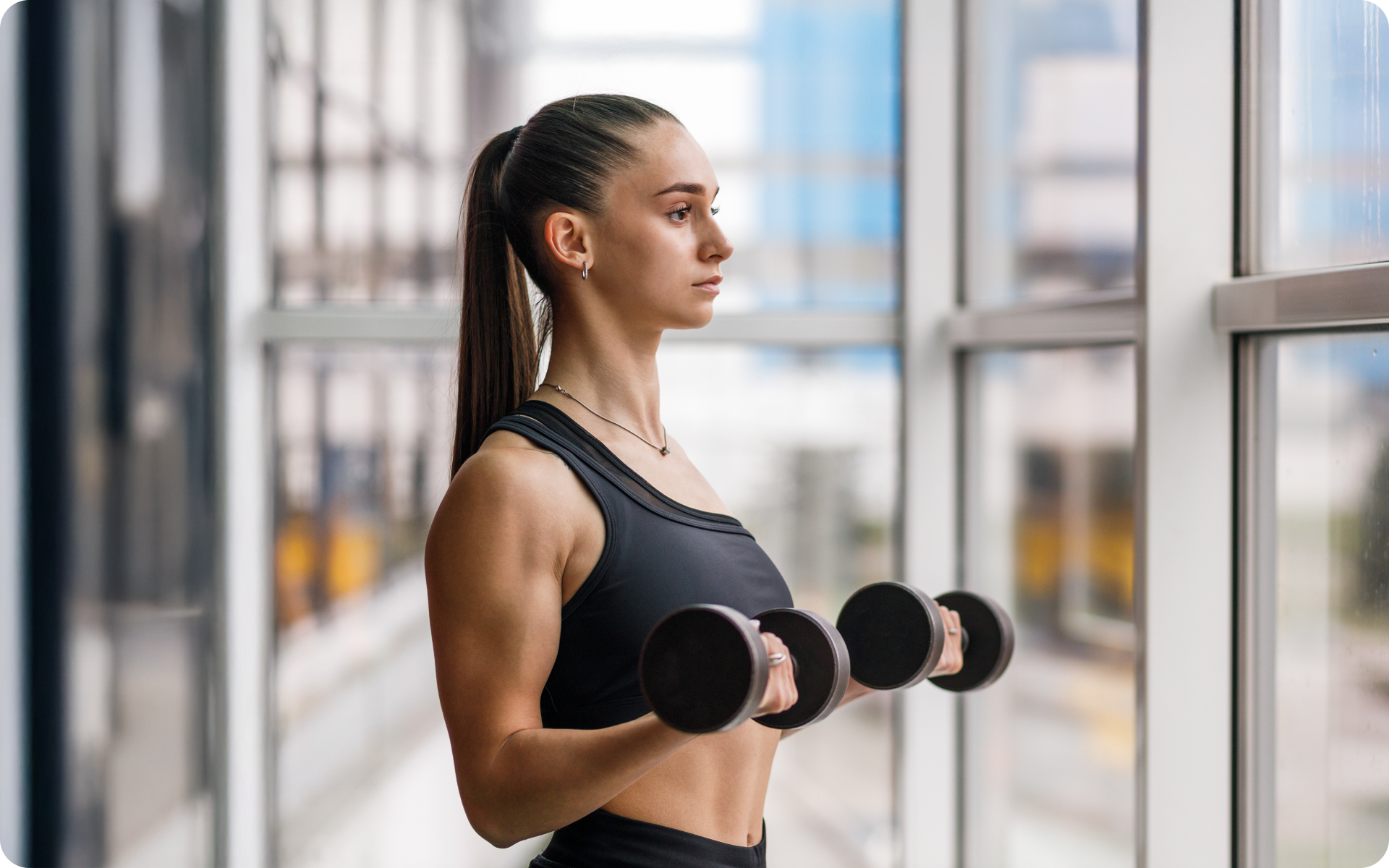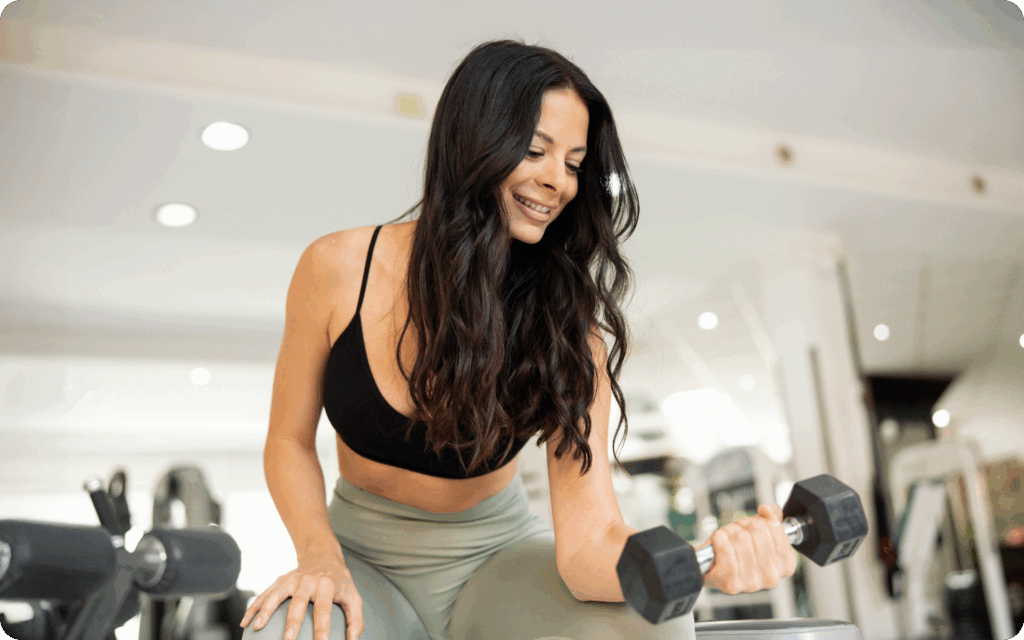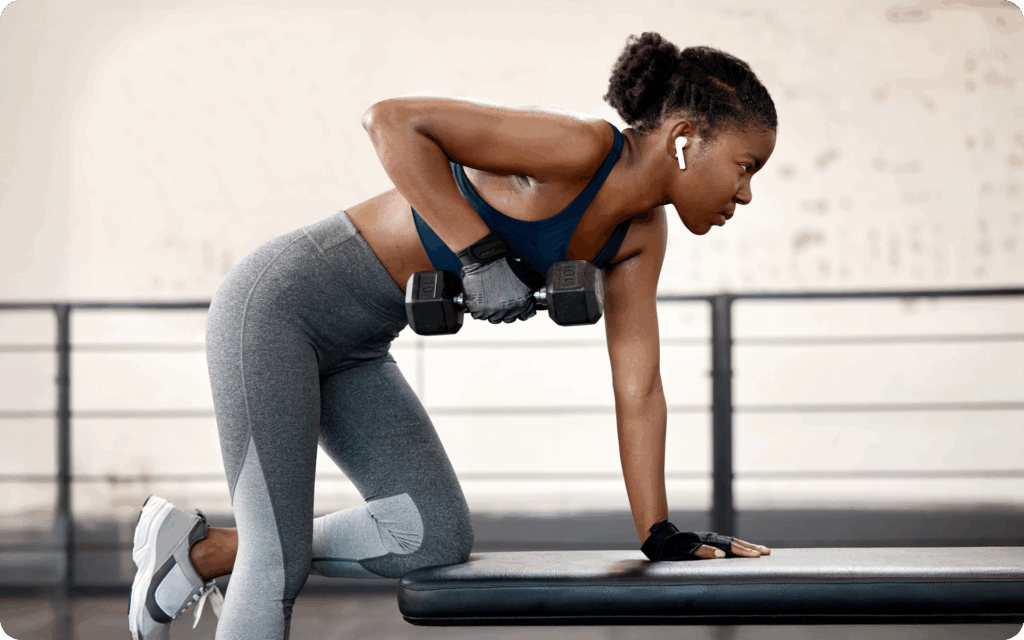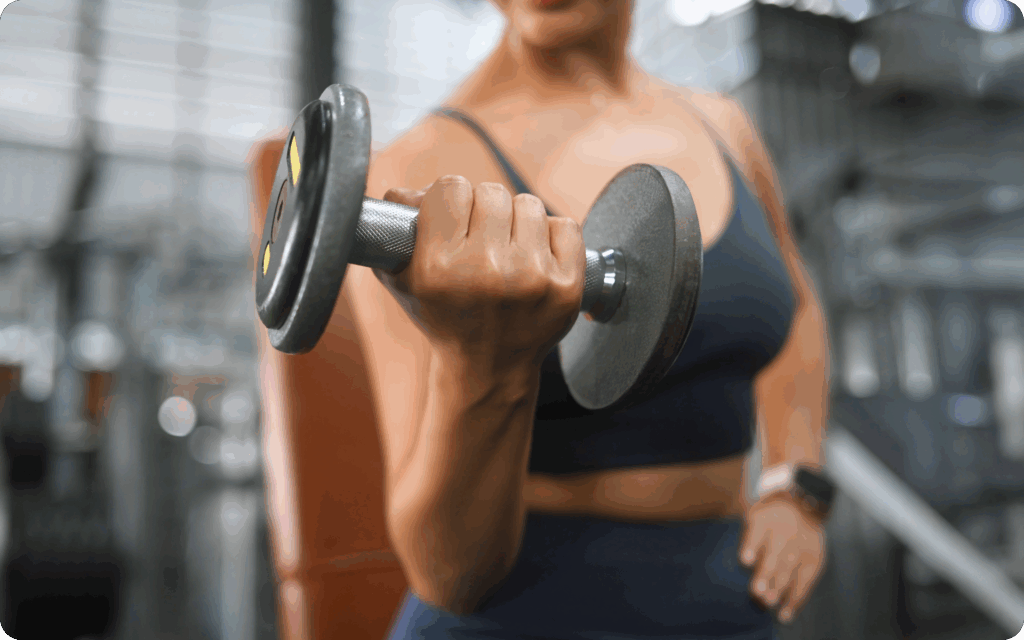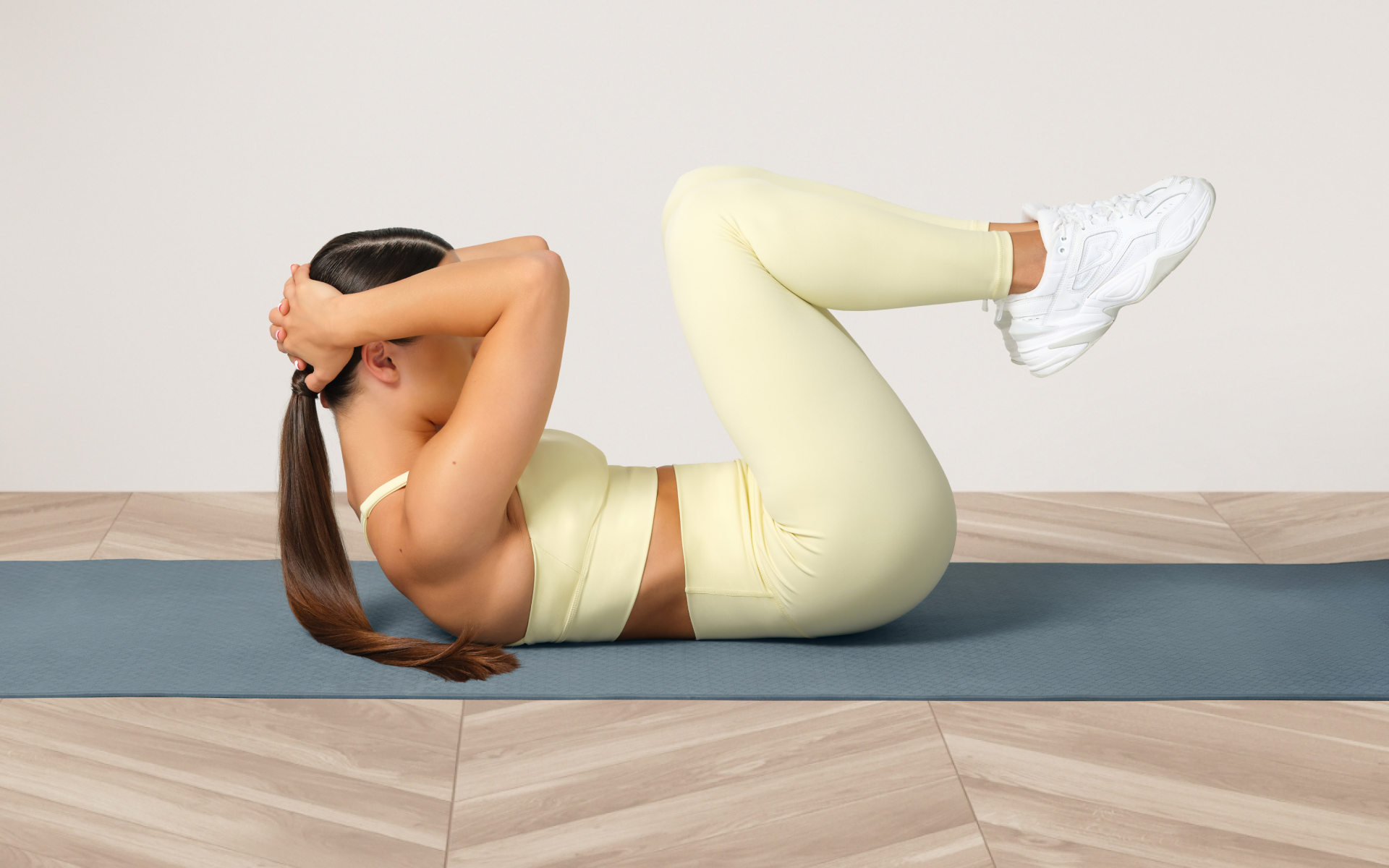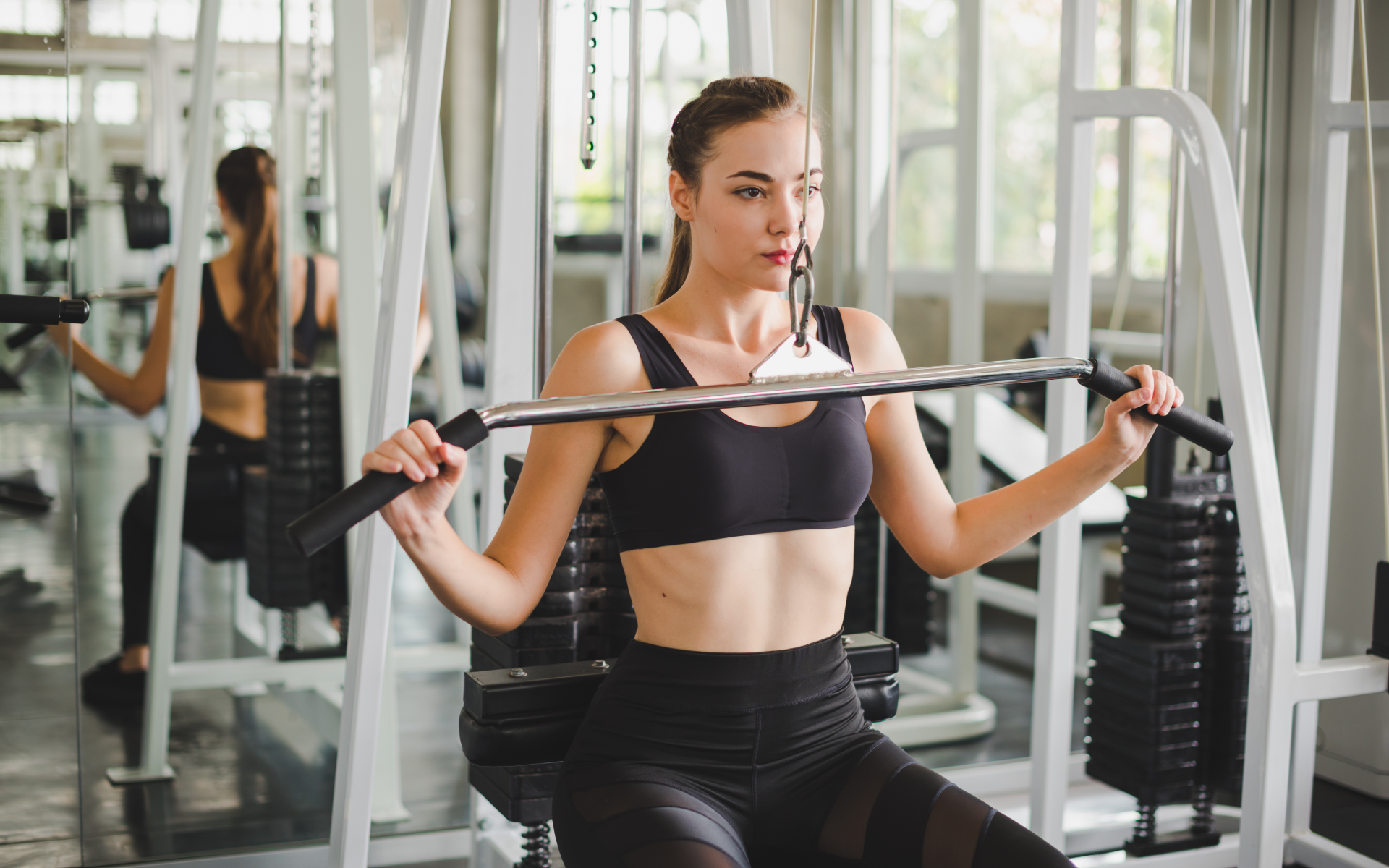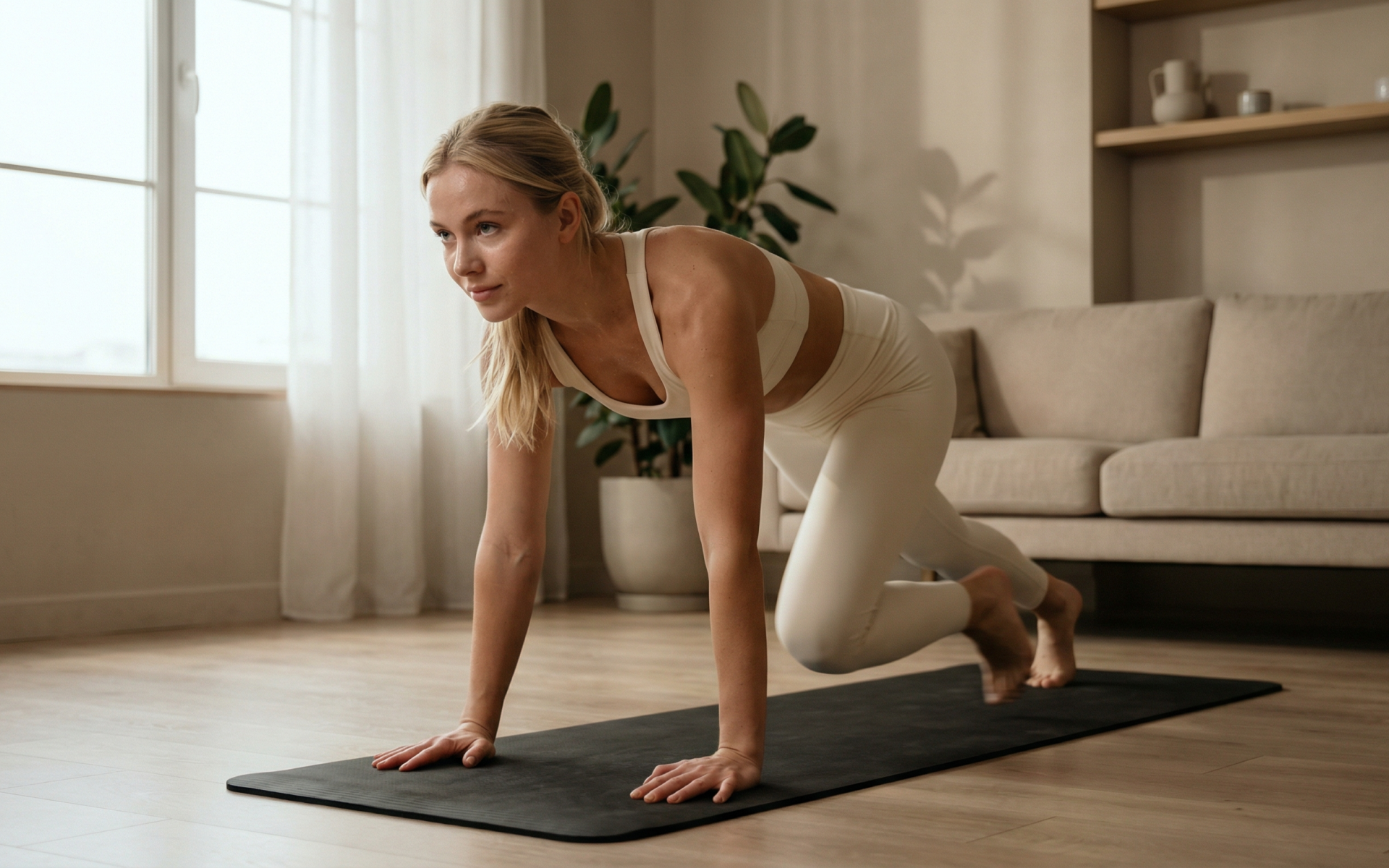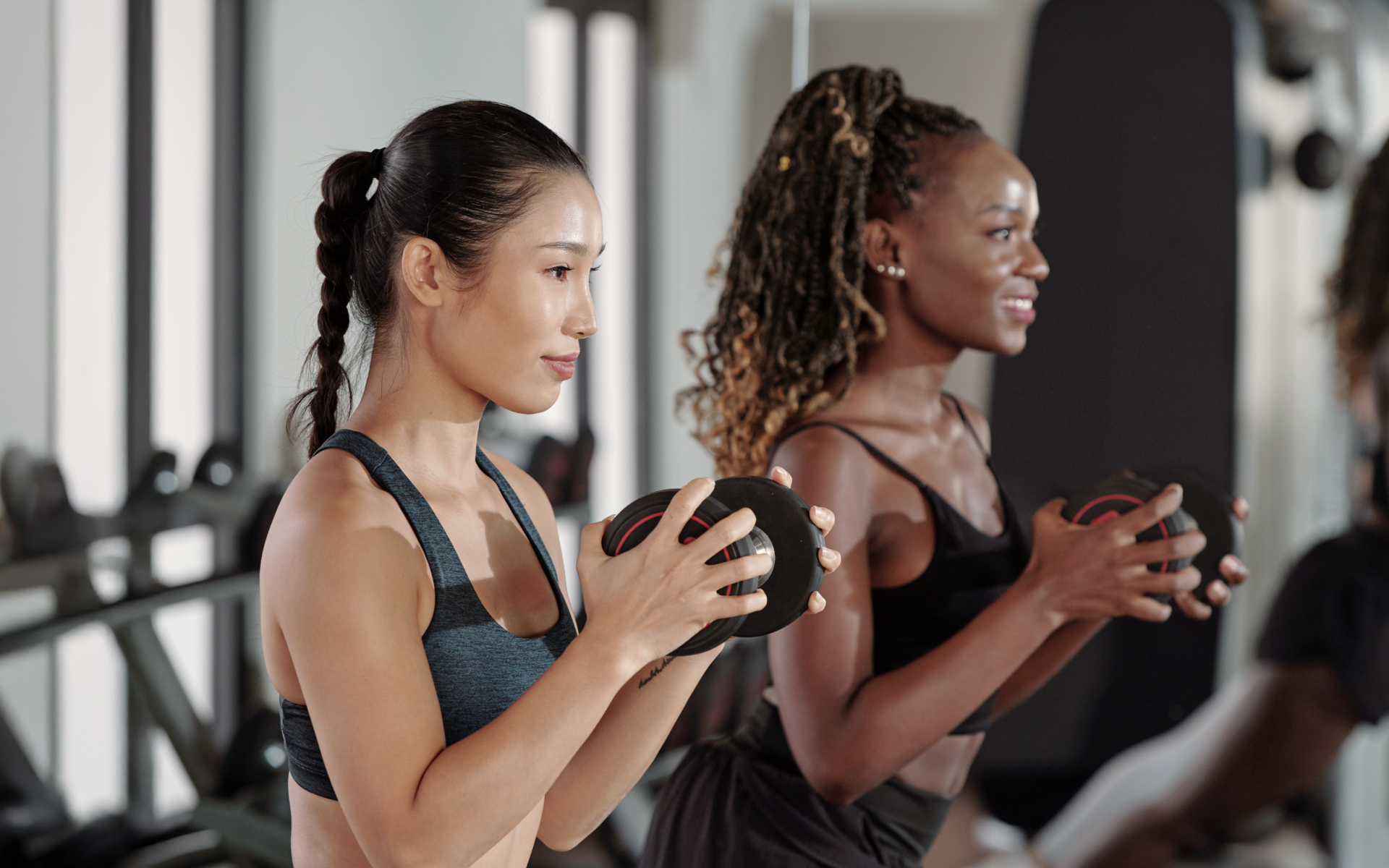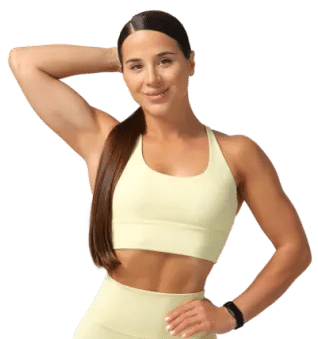According to studies on dumbbell training, exercising with free weights has multiple benefits, including improved athletic performance, better weight management and control, enhanced grip and back strength, a higher resting metabolic rate, a reduced risk of illness, and overall health promotion (1, 2, 3).
But how does dumbbell training fare for upper-body gains? Can using only these free weights lead to improved muscle mass and strength? And which upper-body dumbbell exercises are likely to lead to the best results?
Let’s explore how you can achieve the above goal and more with an upper-body dumbbell workout.
What Is a Targeted Upper-Body Dumbbell Workout?
A targeted upper-body dumbbell workout is an exercise routine that utilizes only dumbbells and has the primary objective of growing and increasing muscle mass in the upper body – i.e. the arms, chest, shoulders, back, and core (abs).
Can You Build Upper-Body Strength With Only Dumbbells?
Yes, you can build upper-body muscle strength and mass using only dumbbells. Here are some studies that demonstrate this:
2010
In this study, researchers took 93 underweight women and 73 obese women and divided them into three training groups: a free weights group, a supine vertical bench press machine group, and a seated horizontal bench press machine group.
This study aimed to see how the above training modes would affect upper-body gains in these women. After a 12-week study period where all the women exercised three times a week, the researchers reached the following conclusions (4):
- Regardless of training mode – the use of free weights or machinery – all the women experienced upper-body strength gains.
- Strength gains appeared more significant when tested using the exact equipment used in training – i.e. if you trained the upper body using dumbbells alone and tested your gains afterward with dumbbells vs a bench press machine, the results from the dumbbell test would seem greater than those from the machine test.
- The obese women in the group experienced greater absolute strength gains than the underweight women. This shows that any overweight woman who is wondering if she can see results from an upper-body dumbbell workout routine will certainly reap some benefits (and results) from it.
2013
January
In this study, researchers wanted to see how different sets of workouts would affect muscle mass and strength gains in young men. The eight untrained Japanese men were asked to do a dumbbell workout for arms (specifically a seated dumbbell preacher curl) twice a week for 12 weeks.
They were also supposed to train one arm with 1 set of the exercise and the other with 3 sets of the same. After the study period, researchers concluded that doing three sets of this workout led to more muscle mass and strength gains in these untrained young men than one set of the same. The muscle mass gains were significantly more impressive than the strength gains.
They also stated that to avoid overtraining, young men, particularly beginners, should have one lighter training day in their routine (5). If you’re a beginner who is looking to target the arms with an upper-body workout routine, having a day where you only do one set of the workout can be beneficial to you, according to the researchers in this study.
Here’s a dumbbell arm workout to help you get started.
When it comes to weight loss, progress is made by inches, not miles, so it’s much harder to track and a lot easier to give up. The BetterMe: Health Coaching app is your personal trainer, nutritionist, and support system all in one. Start using our app to stay on track and hold yourself accountable!
May
In this study, researchers hoped to see how different upper-body dumbbell workouts affected muscle activation in women, particularly since the workouts were done on different incline angles. The women used in the study were 12 experienced lifters and 12 beginners.
The women were required to do the bench press but at different angles, i.e. flat bench press, incline bench press, and seated upright shoulder press. The researchers measured muscle activation using the upper trapezius, anterior deltoid, and pectoralis major.
They found that:
- Regardless of experience in lifting, muscle activation was the same for all the women.
- The upper trapezius and front deltoid worked the most during the shoulder press, followed by the incline press, and finally the flat press.
- The bench and incline press worked the chest muscles more than the shoulder presses.
- Upper chest muscles worked harder during the lowering motion of the incline press and the pushing motion of the bench press.
From this, they concluded that dumbbell upper-body workouts are good for muscle activation but the type of incline used will target and activate certain muscles differently (6).
2014
Here, researchers wanted to find out which between a dumbbell workout and a barbell workout, all done on an unstable surface, would lead to the most muscle activation. All study participants did the chest press, and the researchers tested muscle activation on their pectoralis major, triceps brachii, anterior deltoid, and rectus abdominis.
After observing the male study participants, researchers found that:
- Switching from a barbell workout to a dumbbell one increased muscle activation in the chest and core muscles of the participants by 15%.
- Using heavier dumbbells forced the participants’ chest and shoulder muscles to work 54% harder.
- Using dumbbells instead of the barbell on the unstable surface made the core work harder and the muscle activation higher in an effort to help you stay balanced.
From this, they concluded that as using dumbbells on an unstable surface forced chest, shoulder, and core muscles to work harder, such a routine could be the perfect upper-body workout for beginners who are hoping to build their stability and strength and people in rehabilitation who want to improve their stability and core muscle strength (7).
2019
In this study, researchers looked at the effect of certain workouts on muscle hypertrophy in well-trained athletes. Some of the dumbbell workouts used in the study, i.e. dumbbell curls and dumbbell shoulder press, showed increased muscle hypertrophy results and better results when heavier weights were used and when done in a superset workout (when you perform two different exercises back-to-back with minimal or no rest in between (8).
Read more: 1-Hour Upper Body Workout: How To Create The Perfect Plan For Your Goals
2020
In this study, researchers wanted to see how popular chest workouts – the barbell bench press and dumbbell flyes – affected the muscles in the chest and shoulders. The study was done on 17 men in their early 20s, all of whom had approximately 5 years of resistance training.
From their findings, researchers concluded that the barbell bench press worked best for muscle activation in the chest, triceps, and front shoulder. Dumbbell chest fly, on the other hand, led to better muscle activation results in the biceps (9). If you’re trying out a new upper-body workout at home routine, you can see which workout will work best for which muscles.
Are you new to at-home workouts? Here’s a home workout plan with dumbbells to help you get started.
Are Dumbbells Enough to Build the Chest?
Yes, they can be. While the barbell is typically the most popular free weightlifting method for building chest gains, dumbbells can also work. As shown from the studies mentioned above, exercises with these free weights can activate chest muscles, which will lead to the desired gains (6, 9).
If you want to aim for your back muscles, this article on the best back workouts with dumbbells can help you do so.
What Are Some Good Upper-Body Exercises with Dumbbells?
Incline Dumbbell Chest Fly
Muscles worked include the upper pectoralis major muscle, the anterior deltoids, and the triceps. There is also some slight activation of the biceps, as mentioned in the above section and previously listed research article.
How to perform them:
- Start with your back flat on an incline bench (about 30 degrees) and hold a dumbbell in each hand.
- Ensure that your arms are at chest level at your sides and the elbows are bent and pointing out.
- On and exhale, lift your arms above your chest. Hold for two seconds.
- On an inhale, slowly lower your arms to your sides to come back to the starting position.
- This is one rep. Repeat for 10 to 12 reps for a full set. Do up to 3 sets for a full workout.
Bicep Curls
Muscles worked include the biceps and the brachialis and brachioradialis that are found in the upper arm and forearm, respectively.
How to do bicep curls:
- Start by standing tall with your feet approximately hip-width apart and your core muscles engaged. Pull your belly button to your spine and keep breathing.
- Holding one dumbbell in each hand with your palms facing forward, let your arms relax down at your sides.
- Keep your upper arms stable and your shoulders relaxed, exhale, bend at the elbow, and lift the weights so that the dumbbells approach your shoulders. Ensure that your elbows remain tucked in close to your body.
- Hold at the top position, then on an inhale, slowly lower the weights to the starting position.
- This is one rep. Perform 12 reps for a full set and 3 sets total for a full workout.
Arnold Shoulder Press
Muscles worked include your deltoids, triceps, traps, and the rotator cuff.
How to do the Arnold press:
- Start by standing with dumbbells held in front of you, your elbows in tight to your waist and your palms facing your shoulders.
- Without letting the elbows flare out to the side, on an exhale, push the dumbbells up overhead while rotating your wrists until your palms face away from you.
- Straighten your arms, pause, then inhale and reverse the movement, ready to repeat.
- This is one rep. Perform 10 reps per set.
Dumbbell Bench Press
This is a great workout to target the chest muscles (pectoralis major and minor), in addition to your triceps and anterior deltoids.
How to do it:
- Pick up a dumbbell in each hand and sit on a bench.
- Slowly lie down and extend your arms so the dumbbells are above you. Rotate your wrists so your palms face each other.
- Retract your shoulder blades by pulling them into the bench and pressing through your feet. You should feel your back arch at this point. This is good.
- Slowly lower the dumbbells in line with your mid-chest. Keep your elbows tucked to your side – don’t push them outward – and lower the weights till they are on either side of your chest.
- Return to the starting position by pushing through your arms, chest, and feet as you lift the dumbbells back up in an arc direction until your arms are extended.
Dumbbell Upright Row
Muscles worked include the deltoids, trapezius, rhomboids, and biceps.
How to do this exercise:
- Grab a pair of dumbbells and stand with your feet shoulder-to-hip-width apart with a slight bend in your knees. Keep your shoulders over your hips, your head and neck in a neutral position, and your core engaged.
- Hold the dumbbells in front of your body with your palms facing your legs. Ensure that, like your knees, your arms also have a slight bend at the elbows.
- While keeping the dumbbells close to your body, lift the weights, slowly pulling the dumbbells up toward your lower chest. Allow your shoulder blades to move naturally with your shoulder joints.
- Hold at this position before slowly lowering the dumbbells to the start position.
- This is one rep. Perform 8 to 12 reps for one set and up to 3 sets for a full workout.
What Is a Solid Upper-Body Dumbbell Workout?
A solid upper-body dumbbell workout is one that ultimately targets a majority of the muscles in the upper body, which include your core, chest, back, shoulders, and arms.
BetterMe: Health Coaching app helps you achieve your body goals with ease and efficiency by helping to choose proper meal plans and effective workouts. Start using our app and you will see good results in a short time.
How Many Times Should I Do Upper-Body Workouts to See Results?
It’s difficult to say as in addition to the workouts you do and how often you do them, the rate of muscle growth and strength gains is determined by other individual factors such as genetic predisposition, hormonal factors, and nutritional intake.
That being said, the consensus is that it takes anywhere between 4 and 12 weeks to see visible muscle gains. Therefore, if you eat right, sleep enough, and do the right exercise, the results will eventually show.
How Long Does It Take to See Results from Upper-Body Dumbbell Workouts?
As mentioned above, it generally takes 4 to 12 weeks (between a month and three months) to start seeing initial visible results from a muscle strength and mass workout routine. It may take up to 6 months or a year to see major gains and differences.
Read more: How to Make Your Forearms Bigger: Effective Forearm Workouts
How Can I Enhance the Effect of Upper-Body Workouts?
-
Consistency
You can’t exercise every other week/month and expect results. You must be committed to weekly workouts to see results. That being said, you should keep the upper-body workouts to about twice a week as this will allow you to train other muscles and provide enough rest for the muscles to repair.
-
Rest
Muscles grow in size and strength when they’re allowed to rest and repair themselves. Contrary to popular opinion, consistently exercising with no rest won’t lead to better results. Allow yourself up to 48 consecutive hours of rest a week.
-
Your Diet
This can make or break your routine. For the best results, eat the recommended calorie intake for your goals and increase your protein intake. According to research, muscle growth demands a daily protein consumption of 1.2 – 1.6 g of this macronutrient per kg of body weight per day (10). However, athletes can consume up to 2.2 g per kg of body weight per day (11).
Yes, it does. As shown in the studies mentioned above, upper-body workouts with free weights such as dumbbells or even gym machinery help improve muscle strength and hypertrophy. Yes, they can. Doing shoulder targeting exercises such as front and lateral raises, delt flys, shoulder press, thrusters, and overhead press with dumbbells can help strengthen and build this area. This depends on your goals. For muscle growth, 30 to 90 seconds of rest is considered optimal. Endurance calls for 30 seconds to a minute of rest at most, while 3 to 5 minutes is considered okay for someone who is training for muscle strength and power (12). Yes, 3 chest exercises are enough for beginners or those who prefer split workout routines.Frequently Asked Questions
Does lifting weights increase upper-body strength?
Can dumbbells build shoulders?
How long should I rest between sets?
Are 3 chest exercises enough?
The Bottom Line
You don’t need a full gym at home or a gym membership to achieve upper-body gains – simple free weights can be enough. If you choose the right workouts, eat well with a high-protein diet, remain consistent with your routine, and rest enough for muscle recovery, you can build muscle mass and strength with an upper-body dumbbell workout.
DISCLAIMER:
This article is intended for general informational purposes only and does not serve to address individual circumstances. It is not a substitute for professional advice or help and should not be relied on for making any kind of decision-making. Any action taken as a direct or indirect result of the information in this article is entirely at your own risk and is your sole responsibility.
BetterMe, its content staff, and its medical advisors accept no responsibility for inaccuracies, errors, misstatements, inconsistencies, or omissions and specifically disclaim any liability, loss or risk, personal, professional or otherwise, which may be incurred as a consequence, directly or indirectly, of the use and/or application of any content.
You should always seek the advice of your physician or other qualified health provider with any questions you may have regarding a medical condition or your specific situation. Never disregard professional medical advice or delay seeking it because of BetterMe content. If you suspect or think you may have a medical emergency, call your doctor.
SOURCES:
- Effects of light resistance exercise using dumbbells and rubber band with mild energy restriction on body composition and physical fitness in obese Korean women (2004, researchgate.net)
- Design of a randomised intervention study: the effect of dumbbell exercise therapy on physical activity and quality of life among breast cancer survivors in Malaysia (2016, pmc.ncbi.nlm.nih.gov)
- A comparative analysis of resistance band versus dumbbell training on explosive strength performance of male track & field athletes (2024, researchgate.net)
- Upper-body strength gains from different modes of resistance training in women who are underweight and women who are obese (2010, pubmed.ncbi.nlm.nih.gov)
- Effects of training volume on strength and hypertrophy in young men (2013, pubmed.ncbi.nlm.nih.gov)
- Shoulder Muscle Activation of Novice and Resistance Trained Women during Variations of Dumbbell Press Exercises (2013, pmc.ncbi.nlm.nih.gov)
- An evaluation of upper-body muscle activation during coupled and uncoupled instability resistance training (2014, pubmed.ncbi.nlm.nih.gov)
- Maximizing Muscle Hypertrophy: A Systematic Review of Advanced Resistance Training Techniques and Methods (2019, pmc.ncbi.nlm.nih.gov)
- A Comparison of Muscle Activation between Barbell Bench Press and Dumbbell Flyes in Resistance-Trained Males (2020, pubmed.ncbi.nlm.nih.gov)
- Systematic review and meta-analysis of protein intake to support muscle mass and function in healthy adults (2022, onlinelibrary.wiley.com)
- Food-First Fueling: When to Consume Protein for Maximum Muscle Growth (2023, usada.org)
- Rest interval between sets in strength training (2009, pubmed.ncbi.nlm.nih.gov)
